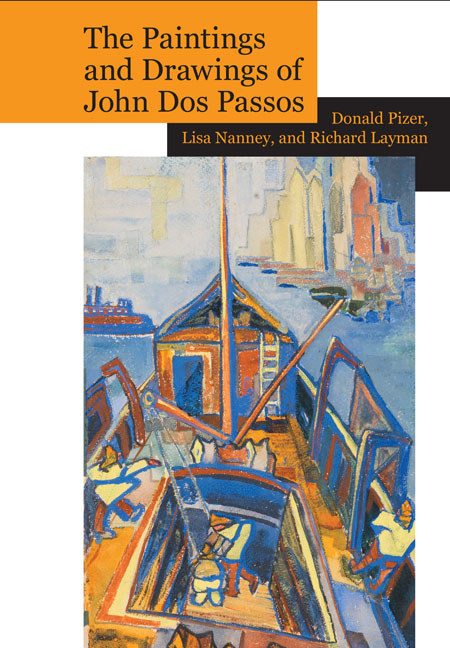Book contents
- Frontmatter
- Contents
- Preface
- Acknowledgments
- The Paintings and Drawings of John Dos Passos: A Collection and Study
- Introduction
- Paintings and Drawings Included in this Volume: A Descriptive List
- Preface to Section 1: Early Work 1918–20
- Preface to Section 2: The Middle East and Morocco 1921–22, 1926
- Preface to Section 3: Paris 1921–25
- Preface to Section 4: New York 1920–24
- Preface to Section 5: New York: Nudes 1920–23
- Preface to Section 6: Theater Designs 1925–28
- Preface to Section 7: Mexico 1926–32
- Preface to Section 8: Later Work 1930–70
- Preface to Section 9: Portraits
- Preface to Section 10: Sea Fronts and Harbors
- Preface to Section 11: Still Lifes
- Preface to Section 12: Studies in Motion
- Preface to Section 13: Abstractions and Other Experimental Modes
- Words and Images: The Visual Art of John Dos Passos
- The Artwork of John Dos Passos
- Notes
- Works Cited
- Index
- Plate section
Preface to Section 1: Early Work 1918–20
from The Paintings and Drawings of John Dos Passos: A Collection and Study
- Frontmatter
- Contents
- Preface
- Acknowledgments
- The Paintings and Drawings of John Dos Passos: A Collection and Study
- Introduction
- Paintings and Drawings Included in this Volume: A Descriptive List
- Preface to Section 1: Early Work 1918–20
- Preface to Section 2: The Middle East and Morocco 1921–22, 1926
- Preface to Section 3: Paris 1921–25
- Preface to Section 4: New York 1920–24
- Preface to Section 5: New York: Nudes 1920–23
- Preface to Section 6: Theater Designs 1925–28
- Preface to Section 7: Mexico 1926–32
- Preface to Section 8: Later Work 1930–70
- Preface to Section 9: Portraits
- Preface to Section 10: Sea Fronts and Harbors
- Preface to Section 11: Still Lifes
- Preface to Section 12: Studies in Motion
- Preface to Section 13: Abstractions and Other Experimental Modes
- Words and Images: The Visual Art of John Dos Passos
- The Artwork of John Dos Passos
- Notes
- Works Cited
- Index
- Plate section
Summary
(Figures 1–7)
Some of the earliest watercolors and pastels in the considerable body of visual work by John Dos Passos document his travels in Spain and Majorca in 1919–20. As noted in the Preface to this volume, dating his visual art is difficult, since he rarely provided any information on the painting itself. But similarities among the subjects, styles, and materials of production in some of the watercolors in this section (figures 5, 6, 7a, and 7b), on leaves from two sketch pads, suggest that they were executed between the summer of 1919 and spring of 1920 when, after his discharge from the Medical Corps following World War I, he journeyed with friends through the Basque country of Spain, across the Picos de Europa, to Madrid and then to Granada. Similar commonalities among figures 1–3, seemingly executed in the same artist's notebook, indicate that they record the sights of his weeklong exploration of Majorca. Distinctly Impressionist, the watercolors in this group reveal that Dos Passos could skillfully manipulate paint in a medium difficult to handle, even more on site than in a studio. The delicacy of the sea, sky, and hilltop village in figure 1, the hillside buildings in figure 3, and the clouds in figure 7a attest to his mastery. Figure 4 demonstrates his expertise in pastels as well and his ability to compose perspectival elements in a landscape; the image possibly depicts Bassano, Italy, where in early 1918 he had served with the ambulance corps and then reveled in a leave of absence that permitted him to explore ancient cities. But although the works in this section echo late nineteenthcentury Impressionist landscapes, they indicate that Dos Passos already was moving toward creating perspective and representing natural forms with mass and color, as Cezanne did in late landscapes that presaged modernist abstraction, rather than with conventional representational dynamics. In figure 6, the arrangement of yellow squares of cottages, green and brown swaths of hills, and blue mountains is rendered in much less finely articulated brushstrokes than in figure 1 or figure 7a. Nearly abstract swatches of blue on fronts of cottages repeat the mass of mountains beyond, uniting and flattening foreground and background. Dos Passos's ability to evoke a scene with minimal formal elements is especially evident in figure 7b, “Granada: Carmen de Matatodos.”
- Type
- Chapter
- Information
- Publisher: Liverpool University PressPrint publication year: 2016



